16-6. In November 25 the Sun should
reach Antares and they should rise together from the
horizon in the east.

At this time of the year
Antares could not be directly observed, because of the blinding
rays from the Sun.
... The
eye is the symbolic site of subjection. Valeri observes
that: 'The two sentiments that permit the transcendence
of the self are, according to Hawaiians, desire and
respect. One and the other are called kau ka maka,
literally, 'to set one's eyes on' ... 'To see' (ike)
in Hawaiian (as in French or English) is 'to
understand', but it is also 'to know sexually'. Witness
to the order, the world of forms generated by the chief,
the eye, is the sacrifice of those who violate that
order. The left eye of the slain tabu-transgressors is
swallowed by Kahoali'i, ceremonial double of the
king and living god of his sacrificial rites. Like the
sun, chiefs of the highest tabus - those who are called
'gods', 'fire', 'heat', and 'raging blazes' - cannot be
gazed directly upon without injury. The lowly commoner
prostrates before them face to the ground, the position
assumed by victims on the platforms of human sacrifice.
Such a one is called makawela, 'burnt eyes' ...
At the other side of the sky,
however, the position of Antares could be deduced from
observing the Pleiades:
 |
 |
|
Eb7-1
(→ 237 - 16) |
Eb7-2
(326 + 222 = 2 * 274) |
|
te tagata puo pouo |
kua hua te hipu |
|
Puo.
(Also pu'a); pu'o nua,
one who covers himself with a nua
(blanket), that is to say, a human
being. Vanaga. 1. To dress, to clothe,
to dress the hair; puoa, clothed;
puoa tahaga, always dressed. 2.
To daub, to besmear (cf. pua 2);
puo ei oone, to daub with dirt,
to smear. 3. Ata puo, to hill up
a plant. Churchill. Hipu. Calabash,
shell, cup, jug, goblet, pot, plate,
vase, bowl, any such receptacle; hipu
hiva, melon, bottle; hipu
takatore, vessel; hipu unuvai,
drinking glass. P Mgv.: ipu,
calabash, gourd for carrying liquids.
Mq.: ipu, all sorts of small
vases, shell, bowl, receptacle, coconut
shell. Ta.: ipu, calabash, cup,
receptacle. Churchill. |
|
Nov
13 (317, *237) |
14
(364 - 46 = 318) |
|
Al Thurayya-27 (Many Little Ones)
/
Krittikā-3 (Nurses of Kārttikeya)
/
TAU-ONO (Six
Stones)
ATIKS =
ο
Persei,
RANA (Frog) =
δ
Eridani
(55.1),
CELAENO (16 Tauri), ELECTRA (17),
TAYGETA (19),
ν
Persei (55.3), MAIA (20), ASTEROPE (21),
MEROPE (23)
(55.6) |
Hairy Head-18 (Cockerel)
/
Temennu-3
(Foundation Stone)
ALCYONE
(56.1),
PLEIONE (28 Tauri), ATLAS (27 Tauri)
(56.3) |
... Now the deluge was caused by the
male waters from the sky meeting the female waters which
issued forth from the ground. The holes in the sky by
which the upper waters escaped were made by God when he
removed stars out of the constellation of the Pleiades;
and in order to stop this torrent of rain, God had
afterwards to bung up the two holes with a couple of
stars borrowed from the constellation of the Bear. That
is why the Bear runs after the Pleiades to this day; she
wants her children back, but she will never get them
till after the Last Day ...
 |
 |
|
Eb7-3 (223) |
Eb7-4 |
|
ka tu te rakau |
te vai okahega |
|
Nov 15 |
16 (320) |
|
MENKHIB (Next to the Pleiades) =
ζ
Persei(57.6)
PORRIMA (γ Virginis) |
ZAURAK (Boat) = γ Eridani
(58.9) |
 |
 |
 |
|
Eb7-5 (225) |
Eb7-6 |
|
te rakau |
te manu |
|
Nov 17 |
18 |
|
λ Tauri (59.3), ν Tauri (59.9) |
4h (60.9)
JĪSHUĬ = λ Persei (60.7)
COR CAROLI (α Canum Ven.) |
 |
 |
|
Eb7-7 (227) |
Eb7-8 |
|
tupu te rakau |
ko raua ka tutu |
|
Nov
19 |
20 (324) |
|
υ
Persei (61.2) |
BEID (Egg) =
ο¹
Eridani
(62.2),
μ
Persei (62.8)
VINDEMIATRIX (ε Virginis) |
 |
 |
|
Eb7-9 (229) |
Eb7-10 |
|
ka tupu te rakau |
ka tu te niu |
|
Nov 21 (229 +
96) |
22 (326) |
|
Al
Dabarān-2 (The Follower)
HYADUM I =
γ
Tauri (63.4)
*22.0 = *63.4 - *41.4 |
HYADUM II = δ¹ Tauri
(64.2) |
 |
 |
|
Eb7-11 |
Eb7-12 (558 →
18 * 31) |
|
kua hua |
atua mata viri |
|
Nov 23
(327) |
24 |
|
Net-19
(Crow)
AIN (Eye) =
ε
Tauri,
θ¹
Tauri,
θ²
Tauri (65.7) |
No star listed (66) |
 |
 |
|
Eb7-13 |
Eb7-14 (326 +
234 = 560) |
|
Erua oona mea ki te puoko |
ka tupu te rakau |
|
Nov 25 (329, *249 = *67 + *182) |
26 |
|
No star listed (67) |
Rohini-4 (The Red One)
/
Pidnu-sha-Shame-4 (Furrow of Heaven)
/
ANA-MURI-2 (Rear pillar - at the foot of which
was the place for tattooing)
ALDEBARAN = α Tauri
(68.2),
THEEMIN = υ² Eridani
(68.5) |
|
Rakau, raau, medicine, remedy, drug.
Ra'a'u, scratch on the skin. Rakau, a
plant. Râkau, goods, property. Vanaga. 1.
Wood; rakau ta, cudgel, stick. P Pau.:
rakau, tree, to dress a wound. Mgv.:
rakau, wood, timber, a tree; medicine, a
remedy; an object. Mq.: ákau, wood, tree.
Ta.: raáu, id. 2. Medicine, remedy,
potion, ointment, furniture, any precious
object, resources, baggage, riches, heritage,
dowry, merchandise, treasure, wealth; rakau
hakaneinei, purgative; rakau nui,
rich, opulent; rakau kore, poor, beggar,
indigent, miserable, an inferior;
hakakamikami ki te rakau, to impoverish;
rakau o te miro, ballast. Mq.: akau,
anything in general. The medicine sense is
particularized in Tonga, Nukuoro, Hawaii,
Tahiti, Mangareva, Paumotu. In no other speech
does wood stand so fully for wealth of
possessions, but it will be recalled that
Rapanui is destitute of timber and depends
wholly upon driftwood. Churchill. |
Aldebaran could also be observed in the Tree (Rakau)
of Metoro, which I think referred to the conglomeration
of beautiful stars
hanging together as if in a Christmas Tree:
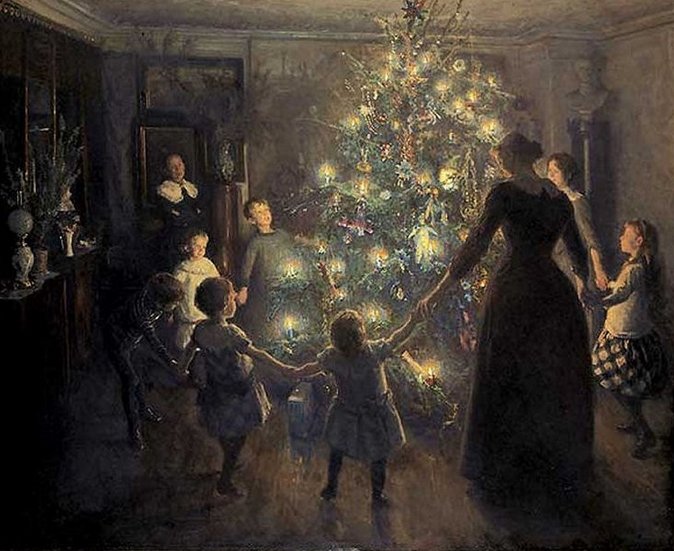
.jpg)
The form of the 'legs' of Aldebaran (the horns of Taurus) might have
been used to illustrate the letter A, with Aldebaran (α)
in the south and Ain
(ε) in the north. And at the
'foot' of Aldebaran was the place for tattooing,
presumably referring to ζ (The
Heavenly Gate):
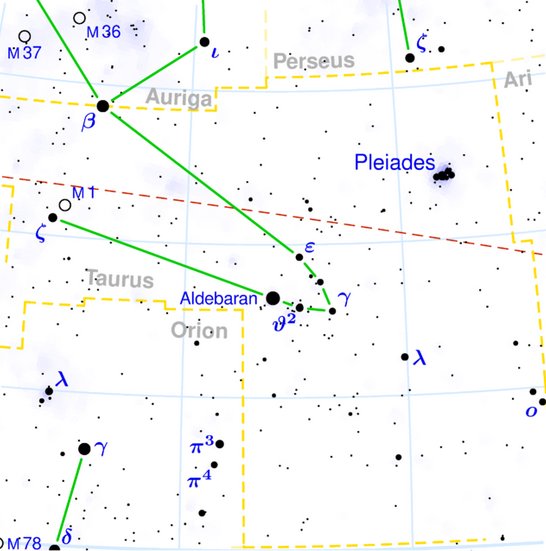
... He continued travelling until he
reached the house of Uetonga, whose name all men
know: he was the tattoo
expert of the world below, and the origin and source of
all the tattoo designs in this world.
Uetonga
was at work tattooing the face of a chief. This chief
was lying on the ground with his hands clenched and his
toes twitching while the father of Niwareka
worked at his face with a bone of many sharpened points,
and Mataora was greatly surprised to see that
blood was flowing from the cheeks of that chief.
Mataora had his own moko, it was done here in
the world above, but it was painted on with ochre and
blue clay. Mataora had not seen such moko
as Uetonga was making, and he said to him, 'You
are doing that in the wrong way, O old one. We do not do
it thus.' 'Quite so,' replied Uetonga, 'you do
not do it thus. But yours is the way that is wrong. What
you do above there is tuhi, it is only fit for
wood. You see,' he said, putting forth his hand to
Mataora's cheek, 'it will rub off.' And Uetonga
smeared Mataora's make-up with his fingers and
spoiled its appearance. And all the people sitting round
them laughed, and Uetonga with them ...

|
Egyptian head |
 |
Phoenician aleph |
 |
Greek
alpha |
Α (α) |
|
In Gardiner's sign list
this is E2, aggressive bull. |
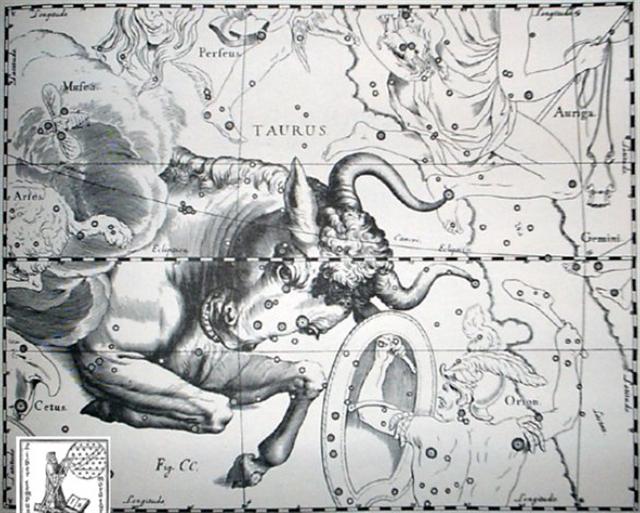
... From Aleph to Taf' describes something
from beginning to end; the Hebrew equivalent of the
English 'From A to Z ... Tav is the last letter
of the Hebrew word emet, which means truth. The
midrash explains that emet is made up of the
first, middle, and last letters of the Hebrew alphabet (Aleph,
Mem, and Tav...).
Sheqer (falsehood), on the other hand, is made up
of the 19th, 20th, and 21st (and penultimate) letters.
Thus, truth is all-encompassing, while falsehood is
narrow and deceiving. In Jewish mythology it was the
word emet that was carved into the head of the
Golem which ultimately gave it life. But when the
letter 'aleph' was erased from the Golem's
forehead, what was left was 'met' - dead. And so
the Golem died ...

 |
 |
|
Eb7-15
(561 → 3 * 187) |
Eb7-16
(236 → 8 * 29½) |
|
to manu mata etahi |
te toga |
|
... The correspondence between the
winter solstice and the kali'i
rite of the Makahiki is arrived
at as follows: ideally, the second
ceremony of 'breaking the coconut', when
the priests assemble at the temple to
spot the rising of the Pleiades,
coincides with the full moon (Hua
tapu) of the twelfth lunar month
(Welehu). In the latter
eighteenth century, the Pleiades appear
at sunset on 18 November. Ten days later
(28 November), the Lono effigy
sets off on its circuit, which lasts
twenty-three days, thus bringing the god
back for the climactic battle with the
king on 21 December, the solstice (=
Hawaiian 16 Makali'i). The
correspondence is 'ideal' and only
rarely achieved, since it depends on the
coincidence of the full moon and the
crepuscular rising of the Pleiades
...
Ue. Uéué,
to move about, to flutter; he-uéué te
kahu i te tokerau, the clothes
flutter in the wind; poki oho ta'e
uéué, obedient child. Vanaga. 1.
Alas. Mq.:
ue, to groan. 2. To beg (ui).
Ueue:
1. To shake (eueue);
kirikiri
ueue, stone for sling. PS
Pau.:
ueue, to shake the head. Mq.:
kaueue,
to shake. Ta.:
ue,
id. Sa.:
lue, to shake, To.:
ue'í,
to shake, to move;
luelue,
to move, to roll as a vessel in a calm.
Niuē:
luelue, to quake, to shake. Uvea:
uei, to shake; ueue, to move.
Viti: ue, to move in a confused
or tumultous manner. 2. To lace.
Churchill.
Toga.
1. Winter season. Two seasons
used to be distinguished in ancient
times: hora, summer, and toga,
winter. 2. To lean against somehing; to
hold something fast; support, post
supporting the roof. 3. To throw
something with a sudden movement. 4. To
feed oneself, to eat enough; e-toga
koe ana oho ki te aga, eat well
first when you go to work. Vanaga. 1.
Winter. P Pau., Mgv.: toga,
south. Mq.: tuatoka, east wind.
Ta.: toa, south. 2. Column, prop;
togatoga, prop, stay. Togariki,
northeast wind. Churchill. Wooden
platform for a dead chief: ka tuu i
te toga (Bb8-42), when the wooden
platform has been erected. Barthel 2.
The expressions Tonga, Kona,
Toa (Sam., Haw., Tah.), to
indicate the quarter of an island or of
the wind, between the south and west,
and Tokelau, Toerau,
Koolau (Sam., Haw., Tah.), to
indicate the opposite directions from
north to east - expressions universal
throughout Polynesia, and but little
modified by subsequent local
circumstances - point strongly to a
former habitat in lands where the
regular monsoons prevailed.
Etymologically 'Tonga', 'Kona',
contracted from 'To-anga' or 'Ko-ana',
signifies 'the setting', seil. of the
sun. 'Toke-lau', of which the
other forms are merely dialectical
variations, signifies 'the cold, chilly
sea'. Fornander. |
|
Nov
27 |
28
(332, *70 + *182) |
|
No
star listed (69) |
No
star listed (70) |
Counting from 1775 (the middle of the 'latter eighteenth century) to 1842
(my assumed era for the rongorongo texts) will result in 67 years or
approximately 1 precessionial day (26000 / 365.25 = 71).
This implies my date November 27 (AD 1842) should
correspond to the stars in 28 November (AD 1775). Here the Full Moon
seems not have been close to any important star. Unless
Aldebaran was referred to.

... There are 471 glyphs on the
tablet and each glyph represents a day. But the first
day in the text is not represented by a glyph, because
time flows and the first day cannot be incised in the
wooden tablet before all its 24 hours have been measured
out in full ...
|
 |
35 |
 |
|
ka hakatu ma te rima |
te toga |
|
201 |
236 |
|
Oct 24 (297
→ *360 - *184) |
Nov 28
(333)
ATRIA = α
Tr. Austr. (253.9) |
|
ρ Ceti (35.4)
*360.0 = *35.4 - *41.4 |

|
Sumerian SAG |
 |
Phoenician resh |
 |
Greek
rho |
Ρ (ρ) |
|
... Resh (Arabic:
rāۥ)
is the twentieth letter of many Semitic
alphabets, including Phoenician,
Aramaic, Hebrew ... The word resh
is usually assumed to have come from a
pictogram of a head, ultimately
reflecting Proto-Semitic *raۥ(i)š-.
The word's East Semitic cognate, rēš-,
was one possible phonetic reading of the
Sumerian cuneiform sign for 'head'
(SAG).

.jpg)
...
Then I become aware of ... a presence -
a faint, ghostly glimmering, like
moonglow, that has appeared on the
solstice stone. I don't know how long it
lasts, a second or two only I would
guess, but while it is there it seems
less like a projection - which I know it
to be - than something immanent within
the stone itself. And it seems to
function as a herald for it fades almost
as soon as it has appeared and in its
place the full effect snaps on -
instantaneously. It wasn't there, and
then it's there. As Chris had described,
the effect does curiously resemble a
poleaxe, or a flag on a pole, and
consists of a 'shaft', narrow at the
base but widening a little towards the
top, running up the left hand side of
the solstice stone, surmounted by a
right-facing 'head' or 'flag'. An
instant later an almond-shaped spot of
light, like an eye, appears a few
centimeters to the right of the 'flag'
and the effect is complete. Weirdly - I
do not claim it has any significance -
this flag-on-a-pole symbol is the
ancient Egyptian hieroglyph neter,
meaning 'god', or 'a god' - and not to
be understood at all in the
Judaeo-Christian usage of that word but
rather as a reference to one of the
supernatural powers or principles that
guide and balance the universe.
Manifested here, in this strange Stone
Age temple, it glows, as though lit by
inner fire ...

Marija Gimbutas: 'To sleep within the
Goddess's womb was to die and to come to
life anew'. In a system of reincarnation
the old one must die in order to be
reborn, of course. At midsummer Sun
comes to a standstill, and this must
therefore be an occasion when the 'flame
of life' had to be transported into a
new body. |
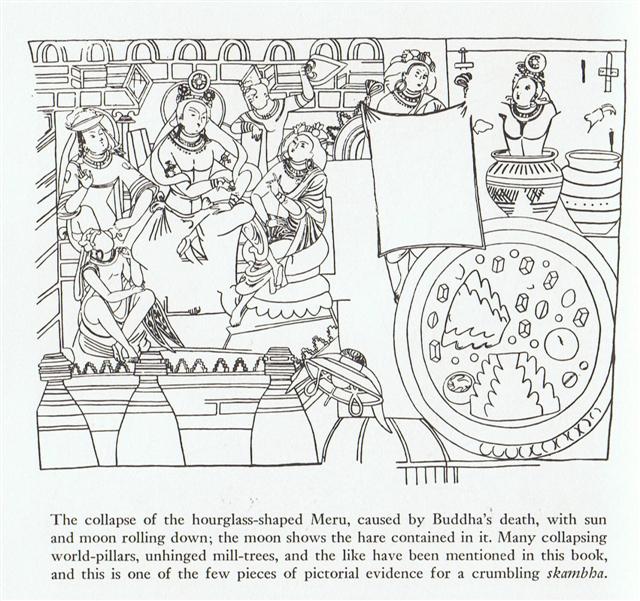
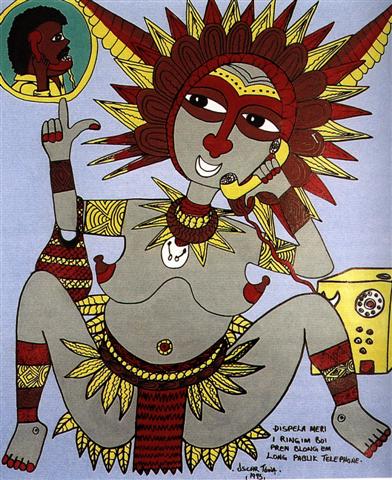
|






.jpg)







.jpg)


